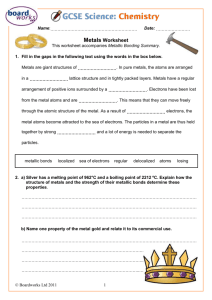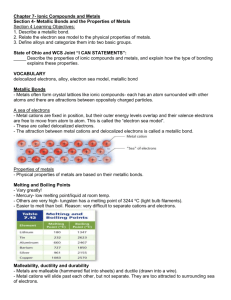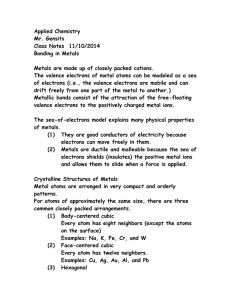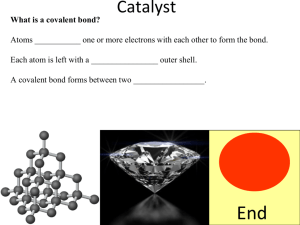metallic bond
advertisement
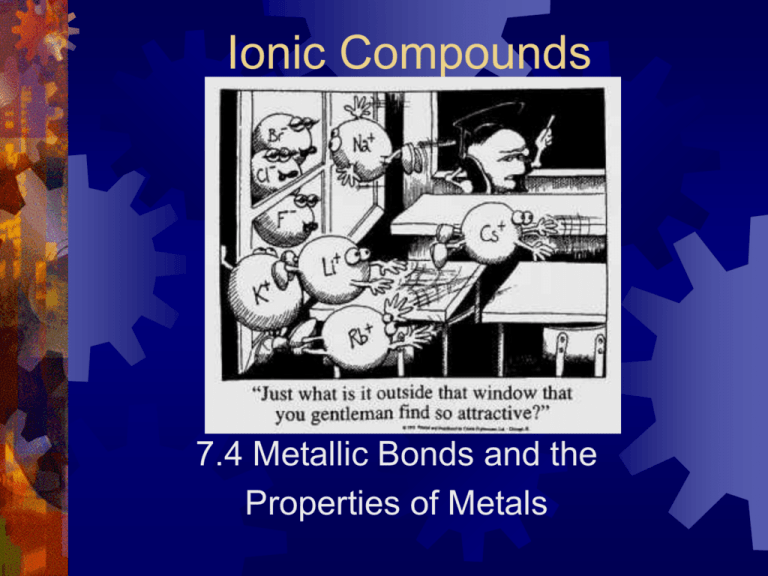
Ionic Compounds 7.4 Metallic Bonds and the Properties of Metals Metallic Bonds Objectives: Describe a metallic bond Relate the electron sea model to the physical properties of metals Define alloys and categorize them into two basic types Metallic Bonds Properties of materials are based on bonding, and the bonding in both metals and ionic compounds is based on the attraction of particles with unlike charges. Metals are not ionic but share several properties with ionic compounds. Metallic Bonds As solids, metal atoms form lattices, similar to ionic crystal lattices. Each metal atom is surrounded by 8-12 other metal atoms. Although metal atoms have at least one valence electron, they do not share these electrons with neighboring atoms nor do they lose electrons to form ions. Metallic Bonds Instead, the outer energy levels of the metal atoms overlap. The electron sea model proposes that all metal atoms in a metallic solid contribute their valence electrons to form a “sea” of electrons. Metallic Bonds The electrons are not held by any specific atom and can move easily from one atom to the next. Because they are free to move they are often referred to as delocalized electrons, with the rest of the atom called a metallic cation. Metallic Bonds Metallic Bonds A metallic bond is the attraction of a metallic cation for delocalized electrons. Properties of Metals In general, metals have moderately high melting points. Cations and electrons are mobile; it does not require extreme amounts of energy to move them past each other. Melting points of metals do vary greatly, however. high boiling points. Atoms must be separated from the group of cations and electrons; requires a lot of energy. Properties of Metals Malleable, meaning they can be hammered into sheets, and ductile, meaning they can be drawn into wire. Mobile particles can be pushed or pulled past each other. Durable Electrons even though mobile, are strongly attracted to the metallic cations. They are not easily removed from one another. Properties of Metals Good conductors Delocalized electrons in metal are free to move, keeping metallic bonds intact. Delocalized electrons move heat quickly from one place to another. Electrons themselves move as part of an electric current when an electric potential is applied to the metal Lustrous Delocalized electrons interact with light Properties of Metals The mobile electrons in transition metals consist of s and d electrons As the number of delocalized electrons increases, so do the properties of hardness and strength. Metallic Bonds Strong metallic bonds are found in transition metals like chromium, iron and nickel. Metallic Bonds Whereas alkali metals are considered soft because they have only one delocalized electron. Metal Alloys An alloy is a mixture of elements that has metallic properties. See Table 13, pg. 228 Metal Alloys The properties of alloys differ somewhat from the properties of the elements they contain. Steel is iron mixed with at least one other element. Properties of iron are present but steel is much stronger than iron alone. Metal Alloys Alloys most commonly form when the elements involved are either similar in size or the atoms of one element are considerably smaller than the atoms of the other. Two basic types of alloys exist. Metal Alloys Substitutional Alloy: Atoms of the original metallic solid are replaced by other metal atoms of similar size. Ex. sterling silver – Cu atoms replace some Ag atoms. Metal Alloys Brass, pewter and 10-carat gold are also examples of substitutional alloys. Metal Alloys An interstitial alloy is formed when small holes (interstices) in a metallic crystal are filled with smaller atoms. Carbon steel (see next slide) Metal Alloys Carbon holes steel in the iron crystal are filled with carbon atoms the alloy formed is harder and stronger, but less ductile, than pure iron

